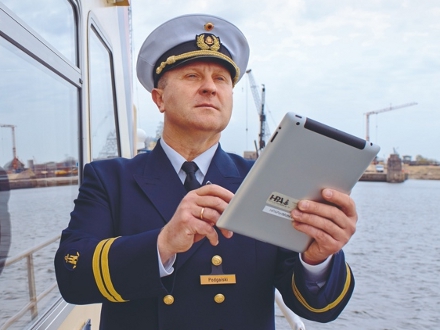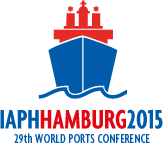
PORT monitor: The smart IT Tool for smooth Vessel Traffic
Every year about 10,000 vessels call at the Port of Hamburg. On land roughly 200 freight trains and approximately 20,000 trucks transit through the port. Given the fact that the port area covers about 75 sq km only, creativity is called for in traffic management. As the existing transport route network in the Port of Hamburg can be expanded to a limited extent only, the Hamburg Port Authority (HPA) is focusing on interlinking systems and fast data transmission: To ensure smooth vessel traffic in the port, the port administration has developed the PORT monitor – a smart IT tool to monitor the area of the Port of Hamburg and its Elbe approach channels.
Vessel traffic on the River Elbe – which is roughly 400 metres broad and separates the port from the city – is heavy and it is growing as cargo volumes rise. Ships are getting bigger and processing at the terminals becomes ever faster. In the past years cruise visits in particular soared in Hamburg. Every year around 180 cruise liners, carrying a total of over 550,000 passengers, call at the Port of Hamburg. In between all these container giants and large cruise ships countless smaller vessels such as ferries, supply and disposal vessels, pilot boats, tugs, the Hamburg Water Police or sports boats bustle about the port – no easy task for the HPA’s Vessel Traffic Service Centre that provides navigational safety in Germany’s largest seaport.
The task of the Vessel Traffic Service Centre is to ensure the environmental performance of ships, the navigational safety and the efficient management of vessel movements in the Port of Hamburg, thus providing the basis for the sustainable growth of Europe’s second-largest container port. Since 2012 the Vessel Traffic Service Centre has been deploying the PORT monitor, an IT-supported control station system that allows for the fast transmission of data and facilitates the monitoring and control of the heavy traffic on the River Elbe. On the basis of geo-referenced data the PORT monitor supplies information about incidents and the conditions on the waterways in the Port of Hamburg, ensuring the safe and smooth movement of ships.
Where just two years ago Excel lists and large magnetic boards were the tools of the HPA’s traffic control station, it’s state-of-the-art technology today: the PORT monitor retrieves information from various single systems, such as for example vessel positions, water levels, berths, bridge heights and widths, current construction sites, planned diving missions, meteorological data and others, and merges it. For about one year now, the PORT monitor has been available as a mobile application for use on tablet PCs. The harbour master and his team can now call up the relevant information at any time during their control trips. At the same time the tablet can be used as a camera and means of communication.
The PORT monitor is one of many components that make the Port of Hamburg a smartPORT. Jens Meier, Chairman of the Management Board of the Hamburg Port Authority, is well aware of that: "By enhancing the PORT monitor we are getting another step closer towards our vision of an intelligent port. The more integrated and harmonised the information system of the Port of Hamburg is, the more it will be able to detect potential disruptions and pass on this information. Our aim is to integrate all modes of transport, thus increasing the efficiency of the port as a major link in the supply chain."
Vessel traffic on the River Elbe – which is roughly 400 metres broad and separates the port from the city – is heavy and it is growing as cargo volumes rise. Ships are getting bigger and processing at the terminals becomes ever faster. In the past years cruise visits in particular soared in Hamburg. Every year around 180 cruise liners, carrying a total of over 550,000 passengers, call at the Port of Hamburg. In between all these container giants and large cruise ships countless smaller vessels such as ferries, supply and disposal vessels, pilot boats, tugs, the Hamburg Water Police or sports boats bustle about the port – no easy task for the HPA’s Vessel Traffic Service Centre that provides navigational safety in Germany’s largest seaport.
The task of the Vessel Traffic Service Centre is to ensure the environmental performance of ships, the navigational safety and the efficient management of vessel movements in the Port of Hamburg, thus providing the basis for the sustainable growth of Europe’s second-largest container port. Since 2012 the Vessel Traffic Service Centre has been deploying the PORT monitor, an IT-supported control station system that allows for the fast transmission of data and facilitates the monitoring and control of the heavy traffic on the River Elbe. On the basis of geo-referenced data the PORT monitor supplies information about incidents and the conditions on the waterways in the Port of Hamburg, ensuring the safe and smooth movement of ships.
Where just two years ago Excel lists and large magnetic boards were the tools of the HPA’s traffic control station, it’s state-of-the-art technology today: the PORT monitor retrieves information from various single systems, such as for example vessel positions, water levels, berths, bridge heights and widths, current construction sites, planned diving missions, meteorological data and others, and merges it. For about one year now, the PORT monitor has been available as a mobile application for use on tablet PCs. The harbour master and his team can now call up the relevant information at any time during their control trips. At the same time the tablet can be used as a camera and means of communication.
The PORT monitor is one of many components that make the Port of Hamburg a smartPORT. Jens Meier, Chairman of the Management Board of the Hamburg Port Authority, is well aware of that: "By enhancing the PORT monitor we are getting another step closer towards our vision of an intelligent port. The more integrated and harmonised the information system of the Port of Hamburg is, the more it will be able to detect potential disruptions and pass on this information. Our aim is to integrate all modes of transport, thus increasing the efficiency of the port as a major link in the supply chain."
smartNEWS



